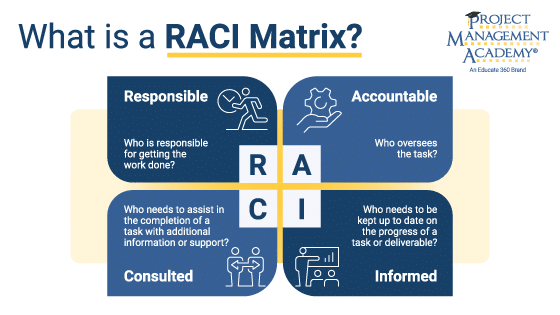Key Takeaways
- Clear accountability prevents project chaos – Without ownership, tasks get missed, deadlines slip, and frustration builds.
- Project management tools define roles and track progress – Methods like the RACI matrix, WBS, and KPIs eliminate confusion and keep teams aligned.
- Trust and autonomy drive accountability – People take ownership when expectations are clear, feedback is constructive, and they aren’t micromanaged.
- Consistency makes accountability stick – Regular check-ins, transparent tracking, and positive reinforcement ensure accountability becomes the norm.
Why Accountability Makes or Breaks a Project
You’re kicking off a high-stakes project. The team is motivated, deadlines are set, and expectations seem clear. But as the weeks go by, things start slipping. Tasks fall through the cracks because no one is sure who owns what. A critical deadline is missed because someone assumed someone else was handling it. When leadership asks what happened, the blame game begins—finger-pointing, frustration, and “I thought they were handling it.”
Does this sound familiar? This happens when accountability isn’t built into the process. Without clear ownership, projects spiral into chaos. People avoid taking responsibility, deadlines get pushed, and tension builds. On the other hand, when accountability is a core part of project management, teams run like a well-oiled machine. Everyone knows their role, communication is clear, and deliverables don’t just get completed—they get completed on time.
But let’s be clear: accountability isn’t about blaming people when things go wrong. It’s about ensuring everyone understands their role, has the tools to succeed, and feels empowered to take ownership. That’s where project management comes in.

Let’s examine how structured project management processes create an environment where accountability isn’t an afterthought—it’s the foundation of success.
No More Guesswork: How Project Management Defines Responsibilities
When accountability is unclear, people waste time figuring out who’s responsible. Tasks get delayed, meetings become “Who’s handling this?” loops, and small miscommunications become significant roadblocks. Project management tools cut through the confusion. When everyone knows their responsibilities and sees what others are working on, collaboration improves, and projects stay on track.
The RACI Matrix: No More “I Thought You Were Handling That”
The RACI matrix (Responsible, Accountable, Consulted, Informed) is a powerful tool defining who is assigned what. It eliminates gray areas, so every team member knows:
- Who’s responsible for doing the work.
- Who’s accountable for ensuring it gets done.
- Who needs to be consulted before decisions are made.
- Who needs to be informed of progress.
With a RACI matrix, there’s no more finger-pointing or crossed wires—just clear ownership from the start.

Breaking It Down: Work Breakdown Structure (WBS)
Big projects can feel so overwhelming that people often don’t know where to start. And when that happens, they don’t start at all. That’s where a Work Breakdown Structure (WBS) helps.
After all, how do you eat an elephant? One bite at a time. With a WBS, progress feels doable instead of daunting. A WBS ensures accountability isn’t just a vague concept—it’s attached to specific deliverables.
A WBS is a project management tool that helps break a project down into smaller, manageable parts. Think of it like a family tree or an outline, where the project is at the top, and below it are progressively smaller tasks or components needed to complete it.
How It Works:
- Start with the project goal – This is the main objective.
- Break it into major deliverables – These are the big pieces required to achieve the goal.
- Divide each deliverable into smaller tasks – Keep breaking them down until they are small enough to be assigned and managed effectively.
Why Use a WBS?
- Clarity: It gives a clear structure to the project.
- Accountability: Helps assign responsibilities to teams or individuals.
- Better Planning: Ensures all tasks are identified and nothing is overlooked.
- Progress Tracking: Makes it easier to monitor project completion.
A WBS is often visualized as a hierarchical chart or an outline, making complex projects easier to plan and execute.
Project Management Software: Visibility Keeps Everyone Honest
Modern project management tools like Microsoft Project take the guesswork out of tracking accountability. Tasks have deadlines, assignments are visible, and everyone can see what’s in progress, overdue and who’s responsible for what.
When expectations are documented in a shared project management tool, there’s no room for confusion—or excuses.
Creating Accountability Without the Finger-Pointing
Nobody likes feeling micromanaged, and a culture of blame kills morale fast. When people fear punishment, they stop taking risks, avoid admitting mistakes, and lose motivation. The goal isn’t to enforce accountability through fear. Accountability works best when it’s built on trust, clarity, and shared responsibility—not fear and finger-pointing.
Empowerment Over Micromanagement
People take accountability when they feel ownership over their work—not when every decision is made for them. This means allowing them to solve problems and take initiative without feeling micromanaged.
The key is balance: set clear expectations, provide the right tools, and trust your team to perform. When people know they’re responsible for outcomes—not just tasks—and have the freedom to work in their own way, they stay engaged and motivated.
Psychological Safety: People Speak Up When They Feel Safe
When employees feel safe admitting mistakes and asking questions, they’re more likely to take ownership of their work. If they’re afraid of being punished for errors, they’ll hide problems until it’s too late. Leaders set the tone here. If a project goes off track, focus on problem-solving instead of finger-pointing. When teams know they won’t be punished for honesty, they’ll take responsibility.
Constructive Feedback: Regular Check-ins Make Accountability the Norm
Instead of waiting until something goes wrong, build feedback into your process with regular check-ins—whether weekly meetings, one-on-ones, or retrospectives.
Good feedback loops focus on questions like:
- What’s going well?
- What could be improved?
- What specific actions should be taken next?
It’s not about catching mistakes—it’s about continuous improvement and ensuring everyone stays accountable.
Agile and Scrum: Making Accountability a Daily Habit
Agile project management makes accountability a team effort. Instead of one person controlling everything, responsibility is shared, with each member contributing to planning and committing to deliverables.
Daily Standups: Small Check-Ins, Big Impact
Scrum teams hold daily standup meetings where each person answers three simple questions:
- What did I accomplish yesterday?
- What am I working on today?
- What’s blocking my progress?
When team members share their progress daily, accountability isn’t an afterthought—it’s built into the workflow.
Sprint Planning & Retrospectives: Accountability in Action
- Sprint planning meetings define what work will be completed, who’s in charge of which task, and the set completion timeframe.
- Retrospectives at the end of each sprint allow teams to reflect on what worked, what didn’t, and how they can improve.
This cycle ensures that accountability isn’t just about getting things done—it’s about learning and refining the process over time.
Keeping Score: Tools to Track Accountability
Even the best systems need a way to measure progress. Without visibility, accountability fades, tasks slip through the cracks, and deadlines get missed. That’s why tracking tools matter. They highlight progress, flag bottlenecks early, and keep teams aligned. When expectations are clear, and progress is transparent, accountability becomes part of the workflow, not an afterthought.
“Accountability breeds response-ability.” – Stephen Covey
KPIs & Dashboards: Measuring What Matters
Key Performance Indicators (KPIs) help track more than just numbers—they provide insight into how effectively a project moves forward. They measure key factors like:
- Task completion rates
- Adherence to deadlines
- Project milestones
Tracking these metrics helps teams identify strengths, spot potential issues early, and make informed decisions to keep a project moving forward.
Dashboards provide real-time updates so teams and leaders can quickly see what’s on track, what’s delayed, and where support is needed. This transparency makes accountability a shared responsibility, keeping everyone aligned and focused on success.
Project Reporting: No More “I Didn’t Know That Was Late”
Regular project status reports prevent accountability from getting buried in endless email chains. Whether it’s a weekly status update or a monthly review, consistent reporting keeps teams aligned and aware of expectations.
How to Build Accountability Into Your Team—Starting Today
Creating a culture of accountability can feel like a big lift if it isn’t already built into your workflow. But the best way to start is to take small, intentional steps.
- Set Clear Goals & Roles: Every project should start with a well-defined scope, clear deadlines, and assigned owners for each task.
- Use Documentation to Eliminate Ambiguity: Use a RACI matrix or a WBS to help set expectations.
- Establish Regular Check-Ins: Weekly or bi-weekly meetings help reinforce accountability and allow teams to flag issues before they become problems.
- Use Project Management Tools for Transparency: Track assignments, deadlines, and progress in a shared system.
- Recognize & Reinforce Accountability: Acknowledge when people take ownership. Positive reinforcement makes accountability something people want to embrace, not avoid.
Make Accountability the Default, Not the Exception
Accountability doesn’t happen by accident—it’s created through clear expectations, structured processes, and a culture where people feel empowered to own their work. 58% of organizations fully understand the value of implementing project management to achieve better outcomes.
Pick any strategy from this list and start implementing it. Whether defining roles more clearly, holding daily check-ins, or using a project management tool, the key is consistency.
As you build accountability into teamwork, projects run smoother, collaboration improves, and success becomes the standard—not the exception.


 New Horizons
New Horizons
 Project Management Academy
Project Management Academy
 Six Sigma Online
Six Sigma Online
 TCM Security
TCM Security
 TRACOM
TRACOM
 Velopi
Velopi
 Watermark Learning
Watermark Learning
 Login
Login




 New Horizons
New Horizons
 Project Management Academy
Project Management Academy
 Velopi
Velopi
 Six Sigma Online
Six Sigma Online
 TCM Security
TCM Security
 TRACOM
TRACOM
 Watermark Learning
Watermark Learning